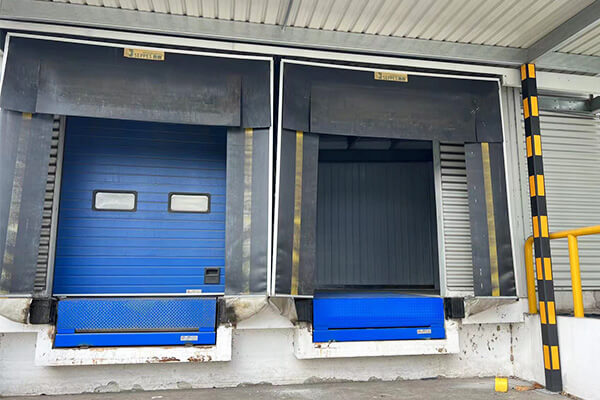Mon - Sat : 9am to 7pm Sunday is CLOSED

In the warehousing, logistics and manufacturing industries, dock leveler is a key equipment to improve operational efficiency and ensure safety. As market demand grows, dock leveler price has fluctuated in recent years. It can be affected by a variety of factors, including equipment type, material selection, brand reputation and market demand. Factories and businesses are often faced with the challenge of choosing the right equipment and controlling costs when making purchases. So what factors actually affect dock leveler cost? How to find affordable dock leveler solutions while ensuring quality?
In this article, we will dive into the key trends in dock leveler price in 2025. By understanding the key factors affecting dock leveler cost. You’ll be able to more effectively budget for your warehouse’s equipment purchases to ensure efficiency and quality while controlling costs.
If you are planning to purchase a loading dock leveler for your warehouse or logistics center. This article will provide you with practical advice to help you optimize your purchasing budget.

Overview of Dock Leveler Price Trends for 2025
As we enter 2025, dock leveler price is experiencing some volatility. With the continuous growth in the logistics industry, dock leveler price is not only influenced by the basic functionality. But also driven by new technologies, material innovations, and changing market demands.
According to industry reports, the market price of hydraulic dock leveler is expected to grow by 3%-5% by 2025, but the exact change in price will also be influenced by fluctuations in material costs and the raw material supply chain.
Factors Influencing Dock Leveler Costs
Type and Functionality Requirements: Manual, Hydraulic, and Electric Dock Levelers
The type of dock leveler has a large impact on price, with manual, hydraulic, and electric being the most common. Typically, the most expensive dock leveler is the electric one, whose automated operation and high load capacity make it ideal for high-frequency operations. Electric models are not only able to automatically adjust the height, but also reduce the labor intensity of the operator, so they are very popular in most modern warehouses.
The manual dock leveler is more common in smaller warehouses due to its simple operation and relatively low price. It is simpler to operate and therefore cheaper. However, the manual type is suitable for low-frequency and lightweight operations and may not be suitable for more demanding environments.
- Manual: The most basic and economical option. Suitable for light cargo loading and unloading and less expensive.
- Hydraulic: Suitable for heavy loads with high load capacity. Operation is more convenient, the price is medium high.
- Electric: High degree of automation, suitable for large-scale warehousing and high-frequency operation of the scene, the highest price.
Brand and Quality
Brand plays a crucial role in determining dock leveler price. Equipment from well-known brands are usually more expensive, but they tend to offer more reliable quality assurance, longer service life and stronger after-sales service. For example, internationally dock leveler brands tend to use high-quality materials and advanced production processes. The performance and stability of their products are relatively more guaranteed.
Comparatively speaking, low-end and mid-range brands may give people a sense of “cost-effective” in the initial purchase. However, in the long run, they may face higher maintenance and repair costs. Low-priced products may save money at the time of purchase. However, the longevity and overall efficiency of the equipment may be compromised.
Price comparison:
- Well-known brands: higher price, but quality and after-sales service are guaranteed.
- Middle and low-end brands: cheaper, but may have quality and maintenance problems.
Materials and Design
Material is another key factor that affects hydraulic dock leveler price. Usually, high-strength steel and aluminum alloy materials are used in high-end dock levelers. They provide stronger corrosion resistance and load bearing capacity. They also extend the life of the device and reduce the frequency of maintenance and replacement. However, they are more expensive to purchase and therefore load dock leveler prices are also more expensive.
In contrast, some low-end models may use traditional carbon steel or thinner steel plates. This reduces manufacturing costs, which in turn makes them more affordable. However, these materials may have some impact on durability and long-term use.
Additionally, the complexity of the design and construction process can affect the price. For example, some dock levelers may come with features such as non-slip surfaces, reinforced frames, and adjustable platforms, all of which can increase the price of the product.
Price Comparison:
- High-strength materials: more expensive, but offer greater durability
- Traditional materials: less expensive, but may sacrifice some performance
Customization Features and Maintenance Costs
Modern dock leveler devices tend to come with more customized features and add-ons, which can also directly push up the price. For example, some warehouse dock levelers offer automated operations, remote control, non-slip surfaces, adjustable platform heights, and more. These add-ons improve the efficiency and safety of the equipment, but they also mean a higher price.
In addition, many suppliers offer installation and maintenance services, the cost of which is often added to the total price. Especially for large enterprises or complex environments with loading dock operations, customized features and comprehensive after-sales services can significantly increase the total purchase cost. Price comparison:
- Standard features: lower price, but relatively basic functionality
- Maintenance and installation services: additional costs, but saves the organization from long-term repair overheads

How to Purchase Loading dock Leveler
Choosing the right equipment configuration
For businesses with limited budgets, avoid purchasing overly luxurious customized configurations. Just choose a standard dock leveler configuration that meets your actual needs. For example, if a warehouse only handles small to medium-sized goods. It may not need automation features or high load carrying capacity.
Consider Total Cost of Ownership (TCO)
In addition to the initial purchase cost, evaluate the total cost of ownership of the equipment. Including energy consumption, maintenance costs, and operator training costs. By selecting high-quality, low-maintenance equipment, long-term operating costs can be significantly reduced.
Regular Maintenance Program
Choose a dock leveler provider that offers long-term maintenance contracts. This not only ensures that the equipment is running in optimal condition, but also avoids unexpected repair costs. Regular maintenance can extend the life of the dock leveler and reduce the incidence of failures.
How to Budget for Dock Leveler Procurement in 2025
Proper budget planning is crucial when purchasing dock leveler price for your warehouse in 2025. Choosing the right equipment requires not only evaluating the initial investment, but also considering long-term maintenance costs and equipment suitability. The following will provide you with detailed budgeting advice to help you ensure that your purchasing decision meets your business needs while effectively controlling costs.
Needs assessment: choosing the right dock leveler
Before setting a budget, it’s important to first assess the needs of your warehouse. Different types of goods, frequency of operations, and scale of loading will affect the type of dock leveler you choose.
- Type of goods: Different goods require different platforms. For example, fragile or light cargo may not require an overly powerful platform, while heavy machinery or bulk cargo will require higher capacity equipment.
- Frequency of operation: If the warehouse has frequent loading operations, hydraulic or electric dock levelers will be more efficient, despite their higher initial cost. For low-frequency warehouses, a manual platform may be a more appropriate choice.
- Load size: Choose the size and load capacity of the platform based on the size of the warehouse being loaded or unloaded. Larger warehouses usually require higher load capacity, while smaller warehouses can opt for simpler equipment.
Budget Recommendations for War
Smaller Warehouses: Smaller warehouses with tighter budgets can usually opt for a manual dock leveler, with a lower initial investment and lower maintenance costs. The budget is around $1,000 – $3,000.
Medium-sized Warehouses: For medium-sized warehouses, a hydraulic dock leveler may be a better choice, offering higher efficiency and a longer lifespan. Budget around $4,000 – $6,000.
Larger Warehouses: Larger warehouses may require electric or automated dock levelers that are capable of handling larger loads and improving operational efficiency. Budgets can range from $7,000 – $12,000, depending on the features and brand of the equipment.
Finding Discounts and Deals
When purchasing dock levelers, there are a number of strategies that can help reduce the overall cost of purchasing.
Negotiate with vendors
When negotiating prices with equipment vendors, in addition to asking directly for discounts, consider making requests for longer contracts or regular purchases, which are often offered by vendors.
Bulk purchasing
If your company has multiple warehouses or plans to expand in the future, consider bulk purchasing. Not only will this get you better pricing, but it will also reduce shipping costs for individual pieces of equipment.
Seasonal Discounts
Many vendors will offer discounts during specific seasons or promotional periods. Regularly checking for sales in the industry or purchasing during the off-season can be an effective way to save money.
Practical Purchasing Tips
Compare with multiple vendors
Getting quotes from multiple vendors and comparing them not only gives you an idea of the market price, but also allows you to find a more cost-effective product.
Consider the long-term value of the equipment
While equipment that costs more initially may make you hesitant, investing in high-quality equipment avoids hidden costs in the future, given the long-term maintenance, downtime, and loss of efficiency.
Upgrade with existing equipment
If the existing dock leveler is ready to use but operates less efficiently or requires more maintenance, consider upgrading the equipment or adding additional features to avoid the high cost of replacing the equipment altogether.
FAQs
What is the average dock leveler price in 2025?
The average price of dock levelers in 2025 can vary based on the type, material, and brand. Typically, manual dock levelers are the most affordable, ranging from $1,000 to $3,000. Hydraulic and electric models, which offer more advanced features and automation, can range from $5,000 to $10,000 or more. For accurate pricing, it’s best to consult with suppliers and request quotes based on your specific warehouse needs.
Are there affordable dock leveler solutions for small warehouses?
Yes, for smaller warehouses or businesses with lower-frequency operations, manual or less advanced hydraulic dock levelers are often sufficient and more affordable. These options provide good performance at a lower initial investment. It’s important to assess the operational needs and frequency of use before deciding on the type of dock leveler.
How do I budget for a dock leveler purchase in 2025?
When budgeting for a dock leveler purchase, consider both initial investment costs and long-term operational expenses. Begin by assessing your warehouse needs, including the volume of loading/unloading, the type of goods handled, and frequency of operations. Then, balance your budget between upfront costs and future savings on maintenance, energy efficiency, and downtime. Don’t forget to explore bulk discounts or seasonal promotions from suppliers to lower your purchase costs.
